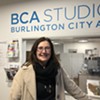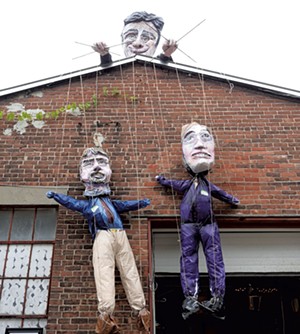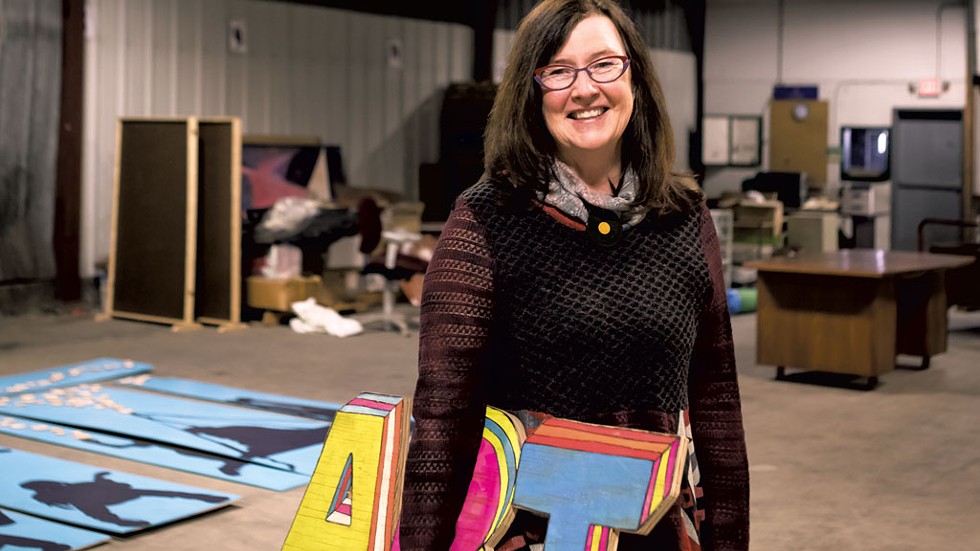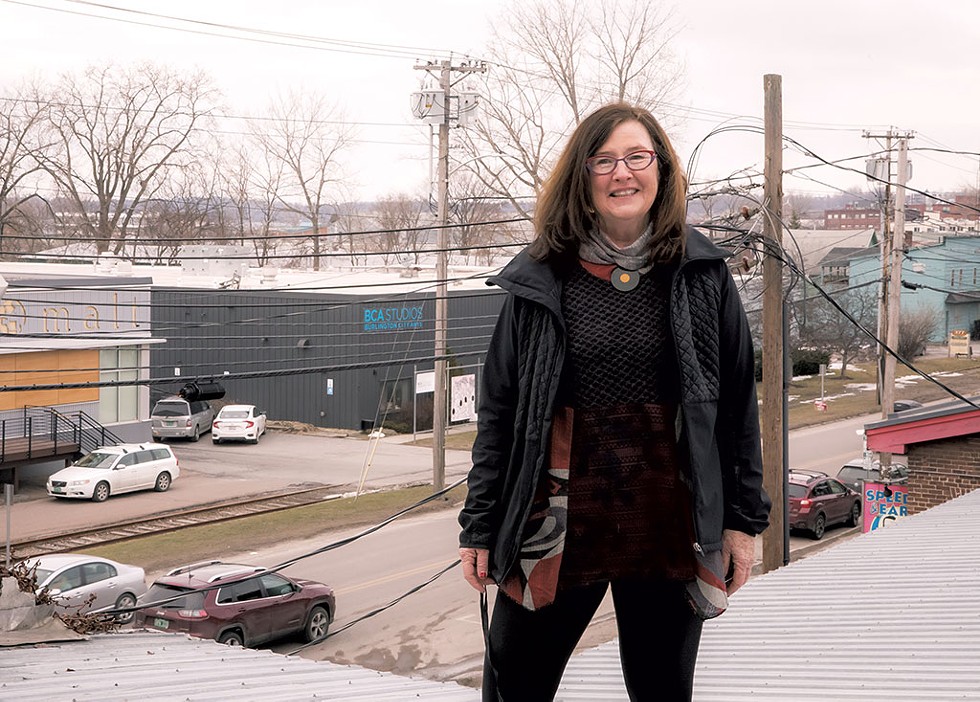Switch to the mobile version of this page.
Vermont's Independent Voice
- News
- Arts+Culture
- Home+Design
- Food
- Cannabis
- Music
- On Screen
- Events
- Jobs
- Obituaries
- Classifieds
- Personals
Browse News
Departments
Browse Arts + Culture
View All
local resources
Browse Food + Drink
View All
Browse Cannabis
View All
-
Culture

'Cannasations' Podcaster Kris Brown Aims to 'Humanize'…
-
True 802

A Burlington Cannabis Shop Plans to Host…
-
Business

Judge Tosses Burlington Cannabiz Owner's Lawsuit
-
Health + Fitness

Vermont's Cannabis Nurse Hotline Answers Health Questions…
-
Business

Waterbury Couple Buy Rare Vermont Cannabis License
Browse Music
View All
Browse On Screen
Browse Events
Browse Classifieds
Browse Personals
-

If you're looking for "I Spys," dating or LTRs, this is your scene.
View Profiles
Special Reports
Pubs+More
After 40 Years and Five Mayors, Doreen Kraft Steers Burlington City Arts Into the South End
Published March 11, 2020 at 10:00 a.m. | Updated March 18, 2020 at 9:45 a.m.
Doreen Kraft doesn't really want to talk about Doreen Kraft. During a recent reception for new exhibitions at the BCA Center on Church Street, she preferred to direct a reporter's attention to everyone else in the room: a dedicated board member; Burlington's supportive mayor; the brilliant director of another local nonprofit.
Upstairs in her office, the longtime executive director of Burlington City Arts praised its successive gallery curators and explained how willing they had been to do hands-on work and volunteer extra time. She talked up a waitress at a restaurant that was partnering with BCA, who, unacquainted with Kraft, recently encouraged her to make a donation to the organization.
Kraft excels at this kind of schmoozing, probing and promoting at the same time. People describe her as a coach, an advocate, a great listener — essentially, who she is to other people, as if her role is to reflect the best version of everyone around her. It's an approach that has helped her grow BCA — through the administrations of five different mayors — from a janitor's closet in the basement of city hall to a municipal department charged with fostering public art and culture.
Since the organization's founding in 1980, Kraft, 68, has been a driving force. For the last 25 years, she's led BCA as it has created galleries and studios, developed art classes and summer camps, curated art in public spaces, won and distributed grants, and organized citywide events such as Festival of Fools and Highlight, Burlington's New Year's Eve celebration. The city contributes a portion of the funds for those cultural activities.
Kraft raises at least half of the rest of the money single-handedly. Most recently, she spearheaded the purchase of a building at 405 Pine Street that now houses the organization's art studios. Kraft and her team need to find $5 million to renovate it.
Related Burlington City Arts Foundation Buys Building on Pine Street

Burlington City Arts Foundation Buys Building on Pine Street
By Molly Walsh
Off Message
"She gets overcommitted. She's always overscheduled. But she's a marvelous fundraiser," said Pat Robins, cofounder of the Church Street Marketplace and former BCA board chair. "Everybody takes her calls. Everybody goes to lunch with her."
Jacqueline Posley, a recent transplant to Vermont by way of the state's Stay to Stay program, joined the BCA board last June. She said that in her home state of Mississippi, she felt the arts were only for people with money. At BCA, she said she felt valued more for her willingness to make connections in the community than the depth of her pockets. She describes Kraft as an inclusive and unpretentious leader.
"Doreen will put out the food trays, will sweep the floors," Posley said. "Every job that needs to be done, I could see Doreen doing it."
Robins credited BCA's long-running success with Kraft's ability to take risks and, more importantly, pull them off. If this story were a documentary, there'd be short takes of nearly a dozen Burlington leaders all saying the same thing: BCA would not exist today without Kraft, despite her attempts to redirect the spotlight. When BCA is praised, Kraft's name is attached. When it's criticized, she is often targeted personally.
This particular arts job also comes with political perils. BCA is an arm of city government and whoever happens to be running it, and Kraft is, technically, an annual appointee of the mayor. She navigates it all with a highly developed sense of direction and diplomacy.
"I love to see and engage with people who believe that the arts are central to community life," Kraft said. "And if I can be a part of that process and move that forward and make that more possible and attainable, then my heart sings." She's deeply loyal to Burlington: "I cannot imagine doing this anywhere else."
Working the gallery opening at the BCA Center, Kraft noticed immediately when Mayor Miro Weinberger walked in. She asked her boss if he'd be willing to speak to the crowd, then jumped into action to corral all the featured artists and curators to start speeches before he had to leave, and gave a glowing, on-the-spot introduction praising Weinberger's support for BCA.
It was a calculated move on Kraft's part, honed from decades of experience. But her words, delivered in a loud but warm New York-accented alto, rang totally authentic.
Government Startup
When he became mayor of Burlington in 1981, Bernie Sanders had an agenda. On it was a desire to "make the arts more accessible to all, regardless of social, economic or physical constraints." But he faced a powerful board of aldermen, known today as the Burlington City Council, who stymied his attempts to hire staff and appoint department heads.
So Sanders created the Community and Economic Development Office, along with a youth office and the Mayor's Task Force on the Arts, to circumvent the board of aldermen's control.
Kraft was appointed to the cultural task force and became its first paid employee in 1983, working out of a closet-size office. Soon known as the Mayor's Arts Council, the group started a concert series in Battery Park and cofounded the Burlington Discover Jazz Festival with the Flynn Center for the Performing Arts in 1985.
In 1990, the Mayor's Arts Council became an official city department, renamed Burlington City Arts. Kraft was on the board at the time but didn't become executive director until 1995. Like Fletcher Free Library, BCA derived only a portion of its budget from taxpayers. Today, it gets 40 percent of its $2.2 million operating budget from the city and 60 percent from philanthropy and outside grants.
Kraft had the requisite fundraising skills to make that arrangement workable. As it turned out, she also had a knack for recruiting young talent.
When Pascal Spengemann came to Burlington in 1995, planning to stay for only a few months, he saw BCA's Firehouse Gallery on Church Street and thought it was cool that there was art on Burlington's main drag. BCA had converted the ground floor of the historic firehouse into a gallery that same year. Through the windows, he saw makeshift walls and paintings hung with fishing line.
But one day during business hours, Spengemann went by and the space was closed. So he went next door to city hall, found Kraft, and convinced her to hire him to supervise the gallery and keep its doors open.
Spengemann lobbied to take over the curatorial duties, and after he put on a well-received test-run show, Kraft let him take the reins.
"I was pretty green and looking for something to do, and she really believed in me," Spengemann said. "I felt really supported by her."
Under his supervision, the Firehouse Gallery began to gain recognition. In 1998, the Burlington City Council approved a proposal to renovate the old firehouse building into a visual arts center, and the newly formed BCA Foundation launched its first capital campaign. In 2004 the renovation was finished, and in 2011 it was renamed the BCA Center.
Today, curator Heather Ferrell cites receiving grants from the Andy Warhol Foundation for the Visual Arts as evidence that the BCA Center is respected in the broader contemporary art community. Many considerations go into the shows the BCA Center puts on throughout the year. Ferrell said they aim for various levels of "accessibility," meaning how much interpretation to add so people can understand and enjoy the work, and how much to challenge the audience.
She also tries to balance showing Vermont artists and national artists, and integrating the two rather than having a separate gallery for Vermonters as was done in the past. For example, local artist Stella Marrs guest-curated the current main-floor exhibit, "Apocalypse Diet," at the BCA Center, featuring Vermont and national artists.
Related Talking Art: Stella Marrs on 'Apocalypse Diet,' Artists and Climate Change

Talking Art: Stella Marrs on 'Apocalypse Diet,' Artists and Climate Change
By Margaret Grayson
Talking Art
Sara Katz started working at BCA in 1999, but it was after she volunteered to help out in Kraft's garden that she got to know the director. The two chatted, pulled weeds and began what is now a 20-year working relationship.
"She's curious about people," said Katz, who has since become the organization's assistant director. "I was just, like, a 22-year-old nobody at that time, and she wanted to know how I thought."
Today, Katz is BCA's behind-the-scenes force, making sure administrative tasks are handled so Kraft has time to be the face of the organization.
"You know, she's just this kind of public dynamo," Katz said. "She's really incredible with human relationships. She just understands people in a really intuitive way, so it makes a lot of sense for her to be out in the world as much as possible."
Filmmaker to Rainmaker
Kraft grew up in New Rochelle, N.Y., and majored in studio art at the University of New Mexico. But, unsure what to do after graduation, she fell in with "a group of merry pranksters," she said. Kraft moved to a farm in Bethel, Vt., as part of the back-to-the-land movement. Though she enjoys gardening, she admitted it was a hard year.
"There was just no question I was not cut out to be a farmer," Kraft said.
She started teaching an art class at a local high school and met Robin Lloyd, who was teaching in nearby Rochester. Lloyd was making films, which Kraft had never done before. But they started working together, and Lloyd taught her the medium. They both moved to Burlington, into the house on Maple Street where Lloyd still lives today, and Kraft went back to school at the University of Vermont, studying film production in the communications department. (She also did stints at Nova Scotia College of Art and Design and Hampshire College.)
Kraft and Lloyd were both influenced by the work of Maya Deren, an experimental filmmaker whose work focused on Haitian vodou. In 1973 the two took the first of many trips to Haiti, where they made a short film about the country's colorful painted buses.
Later, Kraft and Lloyd commissioned local artists to make paintings that they then used in a 20-minute stop-motion animated film, called "Black Dawn," exploring Haitian history. The French government bought copies for all of its embassies; Kraft said it's the only movie of hers that has ever made money. She and Lloyd founded a production company called Green Valley Media in 1974; Kraft still sits on the board.
Kraft also embarked on more personal filmmaking projects, including a re-enactment of her mother's childhood in a convent school in Ireland. Kraft called that still-unfinished work her "film in a can." She'd like to edit it someday, but "it's not something you can do on a weekend," she noted. "I mean, I would need a sabbatical, and they don't have sabbaticals in the arts."
In a way, making films helped prepare Kraft for her job at BCA. "In the early days ... I would be petrified of being onstage or, you know, introducing concerts at Battery Park," she said. "People would push me out there.
"If you have a camera and a microphone, you have an excuse to pretty much ask a lot of questions and get to talk to people," Kraft said. Still, she added, "There are days that I go an entire day and literally, when I get home, I can't speak. I'm, like, done. I have to go through that quiet time, listen to music, listen to news, just transition out of the day and also reflect."
Kraft lives in East Charlotte with her husband, artist Marvin Fishman, whom she met making films. The couple is thinking of moving back to Burlington, where Kraft hasn't lived since the 1990s. If they do it, she said, she'd actually miss the commute, which marks a defined transition between her job and her home.
Kraft doesn't always achieve work-life balance. Most recently, she has lost sleep over the purchase of the new building on Pine Street. A walk through the empty warehouse that BCA now owns — 9,000 square feet of which will be converted into new studio space and a community room — reveals just what a mammoth task this renovation will be. Especially when you factor in BCA's commitment to making the building net zero in energy consumption. Kraft said she hopes to get it done in three years.
She's already started giving tours of the building and reaching out to potential donors. "She's very good at establishing the vision, and she's very good at then asking for people to support it," said Chris Thompson, a former BCA Center curator and former executive director of Generator maker space. "Having done a lot of fundraising myself recently," he added, it taught him that "you have to believe passionately in the mission. And if you believe strongly enough in the mission, you're willing to ask anybody for anything."
South End 'Plan'
click to enlarge 

- Courtesy
- A sculpture of Mayor Miro Weinberger holding puppets of Planning Director David White (left) and Doreen Kraft
Kraft has often been compared to another local woman who built a thriving arts organization: Andrea Rogers. She was the founding executive director of the Flynn, instrumental in transitioning it from a moribund movie theater to a restored art-deco performing arts center. Rogers ran the Flynn for 29 years before retiring in 2010.
BCA focused on the visual arts because it was underrepresented in Burlington's arts scene. Avoiding duplication of the Flynn's performing arts programming and classes was helpful to what Rogers described as a "good working relationship" with BCA, citing their collaboration in producing the annual Burlington Discover Jazz Festival.
"We were both dedicated to our own institutions," Rogers said. "There's no question about that. And I think, because we were early leaders of our institutions, the both of us could be charged with being too protective of our own kingdoms. I'm sure I was considered that, and she probably has been, too."
It's a diplomatic way of acknowledging that Burlington's arts community has seen some turf battles over the years. BCA has run into resistance from the artists and business owners along the Pine Street corridor — later dubbed the South End Arts District — who were protective of their neighborhood and fiercely opposed to any development that might threaten scarce, affordable studio space. They rallied behind the South End Arts and Business Association, which created and still organizes Burlington's annual South End Art Hop.
Whether or not it was warranted, some believed that BCA — and, by extension, Kraft — wanted to stake a claim in the South End, perhaps because of the organization's city-department status.
That came to a head with planBTV. In June 2015, the city released a draft of a plan to redevelop the South End — the postindustrial area of Burlington along Pine Street and Flynn Avenue. BCA, with the help of a National Endowment for the Arts grant, recruited artists to create works that would engage the public and solicit comments on the proposed plan.
But in August, many of those artists became disenchanted with the process and didn't think their voices had been heard. They worried that a proposed zoning change to allow more housing in the area would displace them, and they believed BCA was complicit.
Amey Radcliffe, one of the artists who received funding for a community engagement project, put it this way in a recent email to Seven Days: "I don't necessarily feel that the artist/activists that emerged at that time were fully heard or fully understood. If BCA were less under the purview of the Mayor, we might see BCA taking more independent stands and actions — less in-step with the Mayor's development agendas for the area."
Signs began to appear around the neighborhood, according to local media reports, including ones that read, "BCA: Will you stand with the arts community to preserve industrial zoning in the SEAD?" At that year's South End Art Hop in September, artists built a temporary cardboard house across the street from ArtsRiot that was dubbed "Miroville."
Kraft was also the subject of some Art Hop protest art. One of the buildings in the Howard Space — the warren of artist studios at Pine and Howard streets — was topped with a large sculpture depicting Weinberger holding puppet versions of Kraft and the city's director of planning, David White, on strings.
"I tried to buy it," Kraft said of the artwork. "I stood there that night, and I remember saying to people, 'I do get this. I understand it, you know? I'll take the criticism.' But I also felt that BCA was misunderstood, and our role in that planning."
Relations have improved since then. SEABA's current executive director, Christy Mitchell, said she's excited to have another organization with a stake in the South End and sees BCA as a potential ally in getting new signage and maps pointing tourists to Pine Street. Radcliffe said she thought the perception of BCA in the area was generally positive and that the purchase of the building on Pine Street could provide new opportunities for South End artists.
Steve Conant, owner of Conant Metal & Light and the Soda Plant — and an early member of SEABA — said he'd been aware of a "turf war" between the two organizations, though not when he was directly involved. "It's hard to complain about an organization that anchors 30,000 square feet of real estate and commits it to the arts," Conant said. "That's the biggest risk in the South End: the loss of real estate that supports the arts."
The Politics of Art
BCA's relationship with the city is a double-edged sword. On one hand, it provides the organization with a significant portion of its budget, covering staff and overhead costs. It also provides easy connections with other city departments and a larger stake in city decision making. On the other hand, the public money opens the organization up to criticism about how those funds are used. Dissatisfaction with Weinberger generally casts a shadow on his appointees.
Kraft, one of the original members of the Sanders administration, has another challenge: walking a line between the passionate, activist tendencies of the community and the bureaucratic nature of city government.
John Franco, once Sanders' assistant city attorney, has represented opponents of the Weinberger administration in court; Steve Goodkind, another original Sanders appointee who headed up the Department of Public Works, ran against Weinberger in 2015. Among the original group of Bernie acolytes that former Seven Days columnist Peter Freyne called the "inner circle of Sanderistas," Kraft is the only one still on the city payroll.
Lloyd is a longtime peace activist in Vermont and said that has led to friendly disagreements between her and Kraft. For example, BCA's annual Festival of Fools often lands on the August anniversary of the bombings of Hiroshima and Nagasaki in World War II.
"I said, 'OK, Doreen, you're having a Festival of Fools, but I'm going to walk down Church Street with ashes on my head impersonating what happened in Hiroshima many years ago,'" Lloyd described with a laugh.
Because of their long-standing friendship, Lloyd said, she and Kraft can usually work out a deal when their interests collide. In the case of the Festival of Fools, Lloyd planned her demonstration on the waterfront after the last festival act had performed there.
The women agree to disagree on other controversial city projects, too, such as the long-planned and much-delayed construction of the Champlain Parkway through the South End.
"She's a very loyal person for what she gets involved with," Lloyd said. "I think she's a vital person for Miro, because she has contacts with a lot of people he might not have within the arts community and with the alternative community."
Lots of people confide in Kraft. "Not that she gossips," said Lloyd, "but she could certainly do a lot of gossiping if she wanted to."
"I'm just pretty open and honest with people," Kraft said. "Not that we haven't had knock-down, drag-out debate on certain issues, you know, but I think people respect my role in the city and that you can't have another identity outside of BCA. It's just not possible. I can be active in causes, but I certainly can't take sides, because Burlington City Arts has to be neutral ... I don't think I hold back on my opinion; I just use it appropriately."
Kraft said the BCA board has considered, multiple times, whether staying associated with the city is the best path forward.
"We've gone through that exercise to sort of really look at ourselves at that time and to analyze the relationship with the city," Kraft said. "There have been mayors who said, 'You know, it's a good exercise, because are we holding you back from becoming something you could be more of if you weren't associated with the city?'"
But the answer, Kraft said, is always no — the benefits always outweigh the costs. BCA's new Pine Street studio space proves her point.
"We would not exist if it wasn't for the platform of the city," she said. "Either we wouldn't exist or we'd be a completely independent nonprofit that probably would have accomplished a quarter of what we've accomplished today. I think we stand on the shoulders of the city for what we've done."
Got something to say?
Send a letter to the editor
and we'll publish your feedback in print!
About The Author

Margaret Grayson
Bio:
Margaret Grayson was a staff writer at Seven Days 2019-21. She now freelances for the paper, covering the art, books, memes and weird hobbies of Vermonters. In her spare time she dabbles as a pottery student, country music radio DJ and enthusiastic roaster of root vegetables.
Margaret Grayson was a staff writer at Seven Days 2019-21. She now freelances for the paper, covering the art, books, memes and weird hobbies of Vermonters. In her spare time she dabbles as a pottery student, country music radio DJ and enthusiastic roaster of root vegetables.
More By This Author
Latest in Culture
Related Locations
-
BCA Center
- 135 Church St., Burlington Burlington VT 05401
- 44.47663;-73.21283
-
 802-865-7165
802-865-7165
- www.burlingtoncityarts.org
Related Stories
Speaking of...
-

Vermont Awarded $62 Million in Federal Solar Incentives
Apr 22, 2024 -

Man Charged With Arson at Bernie Sanders' Burlington Office
Apr 7, 2024 -

Police Search for Man Who Set Fire at Sen. Bernie Sanders' Burlington Office
Apr 5, 2024 -

Bernie Sanders Sits Down With 'Seven Days' to Talk About Aging Vermont
Apr 3, 2024 -

Outgoing Burlington Mayor Miro Weinberger Holds Court — for the Last Time — at ‘the Bagel’
Apr 3, 2024 - More »




















































find, follow, fan us: